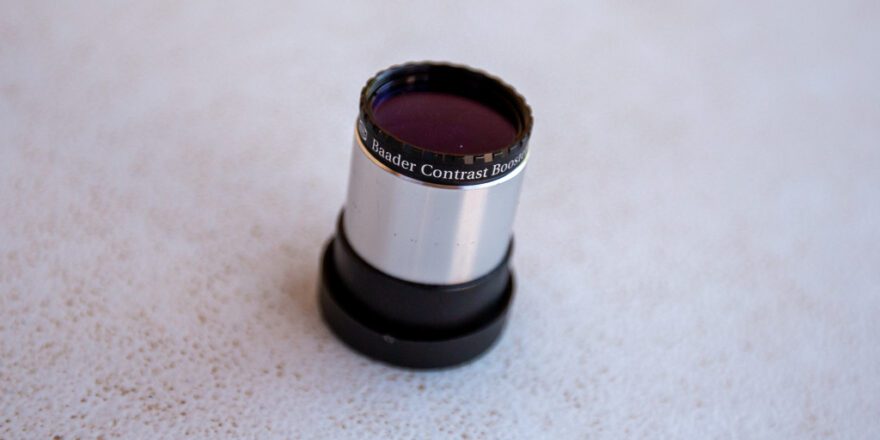In this article we are going to talk about Barlow lenses, which many refer to as the “Swiss Army knife” for astronomers. These are one of the most popular types of astronomy accessories and many times it’s worth picking up one of these before you ever go beyond your first set of eyepieces!
That’s how useful these things are.
What exactly do Barlow lenses do?
Barlow lenses, named after Peter Barlow, magnify the image you are viewing through your telescope. The amount of magnification you get will depend upon what type of Barlow lens that you use. For example, a 1.5X Barlow lens will magnify the image by 1.5X.
You can also find Barlow lenses in the following sizes as well as others:
- 5X
- 3X
- 2X

How do Barlow lenses work?
A lot of people talk about Barlow lenses as if they double or triple your magnification by shortening the focal length of your eyepiece but that’s not how they work technically speaking.
Instead, they actually extend the effective focal length of your telescope.
Remember the formula for magnification where magnification = focal length of telescope / focal length of eye piece?
Well, if you have something like a 2X Barlow lens, that is going to double the length of the telescope’s focal length which means that the magnification will double.
For example, if I put a 2X Barlow lens on my 1200 mm reflector, the effective focal length becomes 2400 mm.
The 10 mm eyepiece that would provide 120X magnification on the 1200 mm, will now provide 240X magnification on the 2400 mm.
And that’s why any eyepiece’s magnification will be doubled if connected to the Barlow lens.
Note that I say doubled but the magnification does not always affect all eyepieces equally. There could be a plus or minus of around 10% depending on the eyepiece.
This is largely because eyepieces not all “parfocal,” which just means that eyepieces don’t have the same focal points.
Want to get started in astronomy?
Our free telescope cheat sheet breaks down the key factors to choosing a telescope and shows you how to get stunning views of planets, nebula, and galaxies!

Why are Barlow lenses so amazing?
There are several reasons why Barlow lenses are so prized.
Gives you more impressive views
Barlow lenses provide magnification that can greatly enhance the viewing pleasure of your subject. For example, I regularly look at the planets with magnification of 120X.
The planets are actually still quite small at this magnification but it’s great because you can also see things like nearby moons. But if I want to get a much closer look at a planet I put on a 2X Barlow lens and then all of a sudden I have 240X magnification which allows me to see things like the division in Saturn’s rings.
It’s quite a game changer.
They effectively increase your eyepiece inventory
When I first started off, I had a 10 mm eyepiece and a 24 mm eyepiece. I soon picked up a 2X Barlow and a 3X Barlow.
What this meant is that I now effectively had the following eyepieces:
3.3 mm, 5 mm, 8 mm, 10 mm, 12 mm, and 24mm.
That’s a lot of high power choices!
When you go to purchase a Barlow lens, think about the “consequences” of purchasing your Barlow lens.
Notice how in the above case, I did not have any repetitive eyepiece focal lengths.
But imagine if my low power eyepiece was a 30mm.
Purchasing the 3X Barlow lens would have made that 30mm eyepiece effectively a 10mm eyepiece which I already had.
So it’s best to do a little bit of math and planning to try to diversify your focal lengths when adding Barlow lenses.
And while you are doing some of that math, keep in mind the maximum useful magnification.
Remember that is about double the telescope’s aperture in millimeters or five times the aperture in inches.
So if I were using my 200mm Dob as an example the math looks like this.
My 10 mm eyepiece with a 3X Barlow effectively becomes a 3.3 mm eyepiece.
With the 1200 focal length on the scope that means that the magnification of the eyepiece is 364X!
That’s very strong but the maximum useful magnification would be 200×2, which is 400X
So in this case I would be good with a 3X Barlow because 364X is under 400X (the maximum useful magnification).

Increase your eyepieces even more?
Some Barlow lenses allow you to disassemble the lens element and this can have a nice hidden benefit.
If you had something like a 2X Barlow lens and you disassembled the lens element and connected that to the eyepiece, it could perform more like a 1.5X.
So once again, it’s like expanding your eyepiece inventory even more.
You’ll have to play around with your Barlow lens and make sure that it has this capability that fits with your eyepieces but it can be a great way to hone in on the exact magnification that gives you the best image.
Related: A Beginner’s Guide to Choosing Astronomy Eyepieces
The limitations of Barlows
Barlow lenses are fantastic but they are not without some limitations and trade-offs.
Reduce brightness
One thing that you will notice when you place one of these on is that they reduce the brightness of the object.
This can become a problem with faint deep sky objects like galaxies and nebulae.
The reduction in brightness is mostly just a normal outcome due to the increased magnification, so it’s usually not anything to worry about.
But because there are additional lenses involved, there is some light loss due to the Barlow itself but it’s usually very minimal, especially on quality Barlow lenses with coatings.
With that said, cheaper Barlow lenses may actually lose out on light due to reflections.
Eye relief
Barlow lenses can also have an effect on your eye relief which if you remember is the distance from your eyeball to the lens of your eyepiece.
If you have a high-power eyepiece it probably has short eye relief so increasing that is not a bad thing for many people.
But if you have a longer focal length eyepiece that already has a long field of view, this might make it hard to keep the object in the field of view.
The good news is that this eye relief issue is more of a problem when using the shorty Barlow’s rather than the long ones, so it’s not always an issue.
Also, there are certain types of lenses that are not true Barlows and these may not have the impact on your eye relief. For example, PowerMates may not impact your eye relief.
Field of view
Barlow lenses do not have an effect on your apparent field of view. Well, at least not always a direct effect.
Recall that apparent field of view is the amount of degrees you can see through your eyepiece when looking at the sky through it.
If you end up extending the eye relief too far it can cause vignetting and that can encroach on your apparent field of view and effectively reduce it 5 to 10% (again not a problem with PowerMates). This can be a problem with shorty style Barlows on longer focal lengths.
A Barlow lens will affect your true field of you because if you recall that formula is: apparent field of view / magnification.
Since magnification will be increased, the true field of view will decrease.
So it’s not really anything unique about the Barlow lens shrinking your true field of view, it’s just the normal way magnification affects your true field of view.
Exit pupil
The Barlow lens will also decrease the size of your exit pupil. For example, a 4 mm exit pupil will be cut down to 2 mm if you use a 2X Barlow.
So if you are dealing with the smaller exit pupil, this might make things more difficult.
Not always practical at high magnifications
As you saw above, you can find Barlow lenses at very high levels including 5X but there are a couple of things to say about these.
First, again, for a lot of eyepieces if you approach 5X you will be beyond your maximum useful magnification.
For example, if I put a 5X Barlow on my 10 mm eye piece on a telescope with 1200 mm focal length, the magnification would be 600X which would be a pretty terrible viewing experience.
And even if you are within your magnification levels, remember that your true field of view is going to get much smaller which means that the object in view could be moving across your field of view pretty quickly.
You might be surprised how fast a planet like Saturn will zip across your field of view at higher magnifications!
Some of these Barlow lenses ranging 3X to 5X are more of an astrophotography tool.
If I ever want to photograph the planets, I’m always using the 3X Barlow I have.
With that said, I have observed some beautiful globular star clusters in my 3X Barlow. In fact, those are some of my favorite deep sky objects to view.
Viewing angles can get a little crazy
Some of these Barlow lenses, such as the longer ones, can result in an eyepiece that is sticking way out from the focuser.
This cannot only look a little ridiculous but the weight of the extra attachment can also cause balance issues at times (especially if you hook a camera up to it).
It can also make viewing the objects a little difficult.
If you have a refractor with a diagonal, you can try sticking the Barlow lens into the telescope first which can help shorten the length you’ll be dealing with and make things better.
On a reflector telescope, you can’t do that and you may just have to just deal with it.
If you’re concerned about Barlow lenses sticking out too much, know that you can select from a shorty style Barlow lens or longer version. (The shorty style Barlows will not stick out as much.)
If you’re thinking about going with a longer Barlow lens, those typically perform well in refractors while the shorty versions do well in reflectors. But opinions differ on this so both can work out on each type of telescope.
One final thing, whenever you are switching out your eyepieces and Barlows, make sure that you take some time to get a feel for the lock screws on these because you don’t want your eyepiece ever falling out.
This is another reason why I like red flashlights because they can help you manipulate these things in the dark without hurting your adjusted eyes too much.
Don’t go cheap
There are some types of astronomy equipment that you can get by with going cheap.
But Barlow lenses may be one area where you want to actually pay for quality.
That’s to help preserve things like light loss but also because you may hold onto these for quite a long time unlike eyepieces which may get replaced quicker.
A high-quality Barlow lens just also feels really great. I love the smoothness of my TeleView 3X.
For quality, look for Barlow lenses that are multi-coated and proven brands like: TeleView, Baader, and Nikon.
Another thing to look for is whether or not the Barlow lens is threaded.
Sometimes if you use filters, you may just want to put the filter on the Barlow lens instead of the eyepiece. But this can be a good thing for you to test to see which you prefer.
Want to get started in astronomy?
Our free telescope cheat sheet breaks down the key factors to choosing a telescope and shows you how to get stunning views of planets, nebula, and galaxies!







